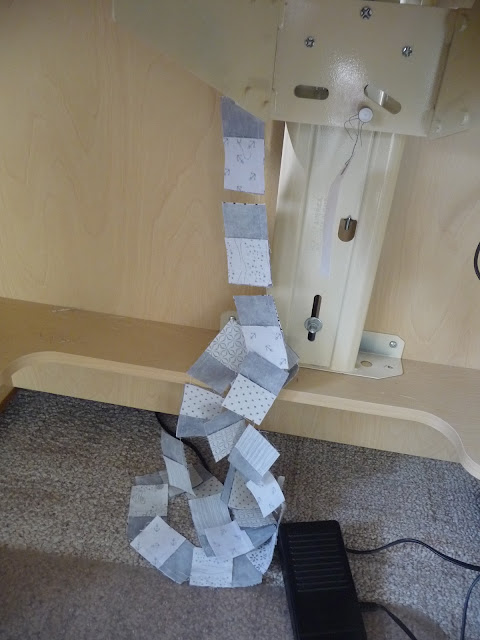Purple Flying Geese!
Step #2 of the Easy Street Mystery Quilt is to make flying geese with the purple and black-and-white fabric.
Usually I use the No-Waste method to make flying geese (shown at the end of this post). But since I had already cut [lots of! too many?] 2" strips of the black-and-white, I decided to follow Bonnie Hunter's recommendation and use a pair of specialty rulers to cut the pieces for these units. I already had one of the rulers, so I went flying (ha, ha) to opening day at the new Pieceful Quilting store to get the other one. If I used the No-Waste method, I'd have needed odd-sized squares to achieve the same size flying geese units. Plus, I wouldn't have had an excuse to go to PQ (as if I needed one).
Cut Those Geese!
The first step is to cut the quarter-square triangle "geese" pieces using the Companion Angle ruler. It creates equilateral triangles, the same as if you quartered a square. The top of the ruler is flat, so you end up with a nice, even line across the top of the flying geese unit (no dog ears).
 |
| Sorry for the glare in these photos. Too gray and rainy to avoid using the flash! |
 Line up the ruler along your strip (see that the bottom line is at the 2" mark and the top is even with the top of the fabric). Line up the left edge so that you cut off the selvage. I'm saving the little triangle pieces -- you never know!
Line up the ruler along your strip (see that the bottom line is at the 2" mark and the top is even with the top of the fabric). Line up the left edge so that you cut off the selvage. I'm saving the little triangle pieces -- you never know!By the way, you might notice that there is some extra fabric peeking out on the left in this photo. This wasn't a first cut, and my cutting had gotten a bit off, as it usually does after half a dozen cuts or so. It was time to even up that edge for a more accurate cut.
Next, turn the ruler to the right. Don't flip it, just rotate it 180 degrees. Now you're ready to cut the next piece.

Just keep rotating, cutting, rotating, cutting, with the occasional correction every couple of pieces.
You can layer your strips to cut up to 4 strips at once. I only did two at a time. Even with a fresh blade (which this was not), the bottom layers seem to get a little weird. This is one quilt I don't want to mess up!
Wing It!

Next up, use the black-and-white (or whatever you're using) 2" strips to cut half-square triangles. There are plenty of rulers you can use, or you can just cut 2" squares in half corner-to-corner. As with its, um, companion ruler, the advantage of the Companion Angle ruler is that it is marked so that you can cut the triangles flat on top, without dog ears.
 I started with the ruler wrong-side up. No matter. The technique is the same as with the Easy Angle ruler -- cut, rotate, cut, rotate, correct...
I started with the ruler wrong-side up. No matter. The technique is the same as with the Easy Angle ruler -- cut, rotate, cut, rotate, correct...Here's the key difference: With the quarter-square triangles, you can layer your fabric for cutting any way you want -- right sides together, right sides up.
But with the wings, you need to be sure to keep the right sides of the fabric together. This is because you want to cut pairs of right and left wings for each flying goose.
Stitch the wings to the geese. I chain-stitched the left wings first. Press them open, seam toward the purple goose, then chain-stitch the right-side wings.
To see master teacher Bonnie demonstrate the technique, she has a nice tutorial on her blog.
As with the 9-patches in Step 1, I didn't try to make all of these units at once. I made units out of one strip of each purple fabric I had on hand. When the mystery is revealed, I'll put the blocks together with the units I've made. Then I'll decide how big I want my quilt to be.
Stay tuned for Step 3, which brings in the blues! Mmmm.
The No-Waste Alternative Method
As I worked through these units, I came to prefer this method with the Easy-Angle and Companion Angle rulers over the "No-Waste" method that I'd been using. Even though there is some waste (those little triangles at the ends of each strip), it's easy to see that things are aligned with those flat tops on the triangles.
With the No-Waste method, you're sewing squares rather than triangles. Even though you're still sewing along the bias, and you have to take time to draw lines on the wing pieces, I have somehow felt more confident with this method. (Not to mention that the projects I've worked on with flying geese have specified measurements to use this method).

There are a bazillion tutorials out there; here's one: http://quilting.about.com/od/quiltpatternsprojects/ss/No-Waste-Flying-Geese-Quilt-Pattern_2.htm
Ironically, as I was putting together this post, I recalled that I also have in my ruler-stash a ruler called the Flying Geese x 4 No-Math Ruler. I got it for my very first quilting class and never used it again. I went back and reviewed how to use it, and discovered that it is actually the No-Waste method. The nice thing is that you don't have to stress about cutting on the 2-7/8" line (or whatever). You just cut your fabric according to the finished size of the unit by following the lines on the ruler. Here's a tutorial on using the ruler.











































